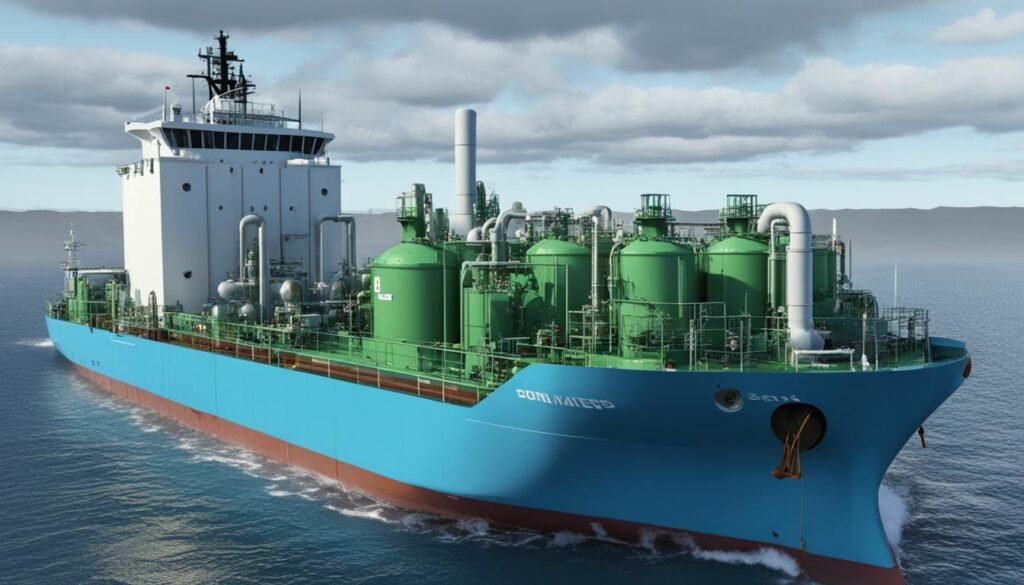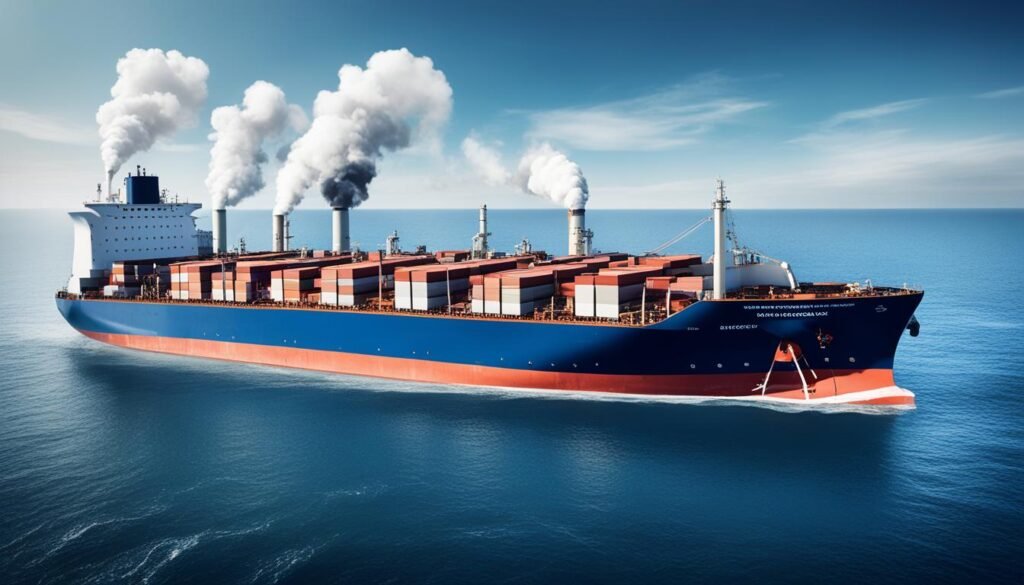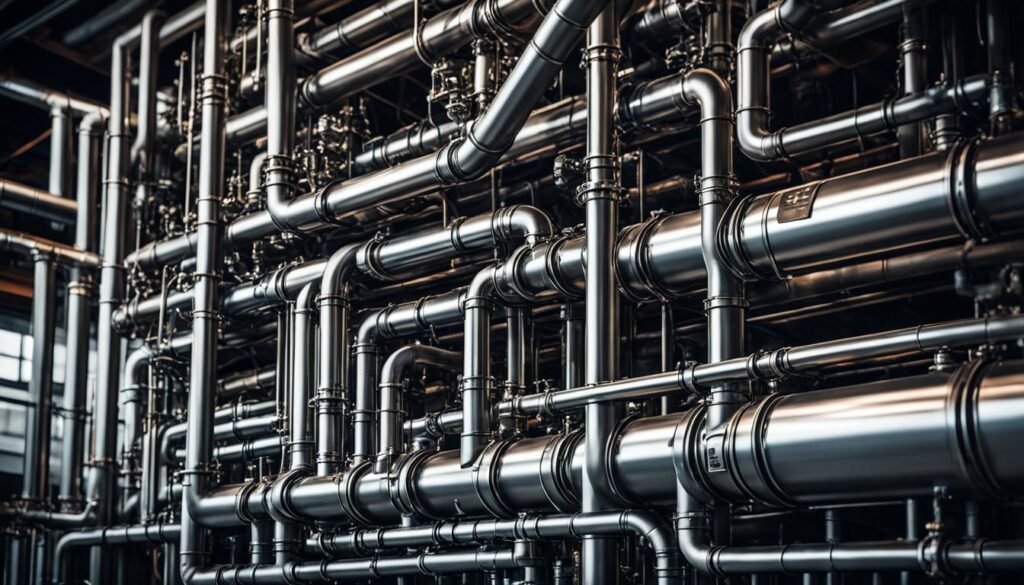As a seasoned cargo ship captain, I’ve seen how important shipping efficiency is for a company’s profits. Fuel and operational costs keep going up, so using energy wisely is key. Waste heat recovery boilers are a great solution that turns ship exhaust into steam power.

No machinery, like the engines on our ships, works perfectly. A lot of energy gets lost as heat, which is wasted. But, what if we could use that lost heat to make steam? That’s what waste heat recovery boilers do.
This article will look into how this technology works and its benefits. We’ll see how it can change the way we use energy at sea. We’ll cover everything from how exhaust gas heat exchangers work to the different types of waste heat recovery systems. We’ll also see how smart shipping companies are using exhaust as an asset.
Introduction to Waste Heat Recovery Boilers
Definition and Overview
Waste heat recovery boilers on cargo ships turn engine exhaust heat into steam power. They use heat exchangers in the exhaust gas channel. This process transfers waste heat energy into steam, hot water, or electricity for onboard use. It boosts the ship’s energy efficiency in propulsion and power generation.
Benefits of Waste Heat Recovery
Using waste heat recovery boilers on cargo ships has many benefits. It leads to better energy efficiency, less fuel consumption, and fewer emissions. By using the heat from engine exhaust, these systems improve the ship’s operations. This results in big fuel savings and helps the environment by reducing emissions.
Waste heat boilers have water tubes that catch heat from exhaust gases. They turn fluid into steam. The steam’s pressure and amount depend on the exhaust’s temperature. These boilers can also use extra burners for more heat. Working with other recovery tools can make them even more efficient by warming up water and making superheated steam.
| Waste Heat Temperature | Typical Applications |
|---|---|
| High-Temperature (>650°C) | Electricity generation, mechanical work |
| Medium-Temperature (100-400°C) | Industrial processes, space and water heating |
| Low-Temperature (0-120°C) | Space and water heating, enhancing industrial process efficiency |
Waste heat recovery systems cut down on pollution and emissions. They also reduce fuel and energy costs. But, the upfront costs might be more than the benefits in some cases.

Principles of Waste Heat Recovery
The key to making waste heat recovery work well is in the design of heat exchangers. Exhaust gas heat exchangers are key. They take the waste heat from exhaust gases and turn it into steam or hot water. This can be used for power or heating.
Exhaust Gas Heat Exchangers
These heat exchangers sit right in the exhaust gas path. They grab the waste heat and transfer it to water, making high-pressure steam. Making these heat exchangers work well is key to a good waste heat recovery system.
Steam Generation Process
The process of making steam from waste heat has several steps. First, hot gases from engines or processes go through the heat exchanger. Here, the heat moves to water, making high-pressure steam.
This steam can power turbines for electricity or heat spaces. Heat recovery steam generators (HRSGs) help make this process even better. They turn waste heat into both electricity and steam. Absorption chillers use this steam for cooling in combined heat and power (CHP) systems.

Waste heat recovery boilers can boost energy efficiency in industries by 20 to 50%. Using these methods, you can save fuel, cut costs, and help the environment.
Types of Waste Heat Recovery Systems
Cargo ships can use several waste heat recovery systems to make the most of waste heat. These systems take the extra heat from sources like the main engine exhaust, jacket cooling water, and charge air cooling systems. They turn this heat into steam, hot water, or electricity.
The exhaust gas boiler is a common waste heat recovery system. It uses the heat from the ship’s main engine exhaust to make steam. This steam can be used for heating, making power, or even making fresh water from seawater.
Economizers are also widely used in waste heat recovery systems. They grab more heat from the exhaust gas to boost efficiency. Flue gas economizers and condensing economizers are two types that recover even more heat.
Some ships use steam turbine generators to turn waste heat into electricity. This electricity helps power the ship, cutting down on fuel use and emissions.
The freshwater generator is another waste heat recovery system. It makes fresh water using heat from various sources. This water is great for drinking, cooking, or other uses, cutting down on the need for desalination.
By using these waste heat recovery systems together, cargo ships can save a lot of energy, and fuel, and reduce their environmental impact. They also keep their ships running smoothly.
| Waste Heat Recovery System | Description | Key Benefits |
|---|---|---|
| Exhaust Gas Boiler | Utilizes heat from main engine exhaust to generate steam | Provides steam for onboard heating, power generation, and desalination |
| Economizers | Extracts additional heat from exhaust gas stream to improve overall efficiency | Enhances heat recovery capabilities, increases system efficiency |
| Steam Turbine Generators | Converts recovered waste heat into electrical power | Generates electricity to power onboard systems, reduces fuel consumption |
| Fresh Water Generators | Uses waste heat to produce freshwater for onboard use | Reduces energy-intensive desalination, provides clean water for the vessel |
Waste Heat Recovery Boilers
Design and Components
Waste heat recovery boilers have important parts to catch and use exhaust gas heat. The main part is the exhaust gas heat exchanger. It takes the heat from the exhaust to make high-pressure steam.
This steam can power a steam turbine or give process heat on the ship. The steam drum, feed water system, and piping are key for the boiler’s efficiency. They make sure the steam is made and moved well, improving energy recovery.
Applications in the Marine Industry
These boilers are used a lot in the marine world, especially on big cargo ships and tankers. They help ships use less fuel, cut costs, and emit less pollution.
Waste heat recovery tech is becoming more common in new ships and updates. It helps meet tough emissions rules and makes shipping greener. By using exhaust heat, these boilers boost the marine industry’s energy use and cut down on pollution.
Improving Efficiency with Waste Heat Recovery
Waste heat recovery boilers are a big win for cargo ship operators. They boost efficiency, cut costs, and lessen environmental harm. These systems can save up to 15% in fuel, greatly reducing what ships spend on fuel. They also make the main engine work less, which means lower upkeep costs and a longer engine life.
Fuel Savings and Cost Reduction
Waste heat recovery boilers are a smart choice thanks to policies like the EU ETS carbon tax. This tax can be paid off in just 2-3 years. For cargo ships, this means a better total cost of ownership and a bigger return on investment.
Environmental Impact and Emissions Reduction
Waste heat recovery boilers are good for the planet too. They use less fuel, which means less CO2, NOx, and SOx emissions. This helps the shipping industry meet its sustainability goals and follow strict emissions rules. Technologies like waste heat recovery help ships become more eco-friendly.
| Benefits of Waste Heat Recovery Boilers | Impact |
|---|---|
| Fuel Savings | Up to 15% reduction in fuel consumption |
| Cost Reduction | Shorter payback period of 2-3 years with carbon tax policies |
| Emissions Reduction | Lowers greenhouse gas emissions and air pollutants like CO2, NOx, and SOx |
| Environmental Impact | Supports sustainability and compliance with stricter emissions regulations |
Integration with Ship Systems
It’s key to link waste heat recovery boilers with a ship’s systems for better performance. The system must fit with the main engine type, like marine diesel engines, marine turbines, or electric or hybrid setups.
For retrofitting, planning is vital to fit new gear in the ship’s tight spaces. Making sure the waste heat recovery system works well with the ship’s energy management is crucial. This approach helps save fuel and cut down on emissions.
Compatibility with Existing Propulsion Systems
The waste heat recovery system needs to match the ship’s propulsion setup, whether it’s direct drive or electric. This ensures the best performance and use of recovered waste heat. Good integration boosts the ship’s energy efficiency, lowers fuel use, and cuts costs.
| Propulsion System | Compatibility with Waste Heat Recovery |
|---|---|
| Marine Diesel Engines | High compatibility, as diesel engines produce significant amounts of exhaust gas heat |
| Marine Turbines | Moderate compatibility, as turbines have lower exhaust gas temperatures than diesel engines |
| Electric Propulsion | Good compatibility, as the waste heat recovery can supplement the electrical power generation |
| Hybrid Propulsion | Excellent compatibility, as the waste heat recovery can be integrated with both diesel and electric components |
By linking the waste heat recovery boiler with the ship’s systems, owners can make better use of space, boost energy efficiency, and lessen environmental impact.
You can also check out this article on Waste heat recovery system
Case Studies and Real-World Examples
The marine industry has seen many success stories with waste heat recovery boiler systems. These systems bring big benefits to cargo ships, container vessels, tankers, and other commercial ships. They help save fuel, cut costs, and improve the environment.
A big container shipping line cut its fuel use by 5% with waste heat recovery boilers. A large oil tanker company saw an 8% boost in energy efficiency with this tech. These stories show how waste heat recovery works well in the maritime world.
Cruise ships are also using waste heat recovery to save energy and reduce emissions. One cruise line reduced its greenhouse gas emissions by 10% with a waste heat recovery program. This shows how cruise ships can be more eco-friendly.
Ro/ro vessels have also gained from waste heat recovery boilers. One major operator saved up to 7% on fuel with these systems. This tech is great for making ro/ro vessels more efficient and green.
These examples give us a look at how waste heat recovery boilers work in real life. They show how they can make cargo ships, container ships, tankers, and cruise ships more efficient. They also highlight the shipbuilding industry’s efforts to be more sustainable.
Conclusion
Waste heat recovery boilers are changing the game for cargo ships and other commercial vessels. They take the heat from engine exhaust and turn it into steam power. This makes ships use less fuel, cut costs, and emit less pollution. It’s a big win for the shipping industry’s push towards being more green and meeting tough environmental laws.
Using waste heat recovery boilers is now key for the maritime sector. It’s under a lot of pressure to reduce its carbon emissions and adopt greener ways. These technologies help ships run better, save money, and are crucial for the industry’s move towards cleaner operations.
The shipping world is always changing, and using waste heat recovery boilers is a smart move for companies. It helps them use energy wisely, lessen their environmental harm, and stay competitive. By tapping into waste heat, these systems are leading the way in making marine energy use, cutting emissions, and promoting sustainable shipping.
FAQ
What are the main benefits of waste heat recovery boilers on cargo ships?
Waste heat recovery boilers boost energy efficiency and cut fuel use. They turn engine exhaust heat into steam. This makes the ship’s systems more efficient, saving fuel and reducing emissions.
How do waste heat recovery boilers work on cargo ships?
These boilers take engine exhaust heat and turn it into steam. This steam can power the ship or provide heat. Heat exchangers in the exhaust system make this possible.
What are the key components of a waste heat recovery boiler system?
The main part is the exhaust gas heat exchanger. It sits in the exhaust channel and moves heat to make steam or hot water. This steam or hot water can power or heat the ship.
What types of waste heat recovery systems are used on cargo ships?
Cargo ships use different systems like exhaust gas boilers and steam turbine generators. These systems take heat from the engine exhaust and cooling systems. They turn it into steam, hot water, or electricity.
How do waste heat recovery boilers improve cargo ships’ energy efficiency and environmental performance?
These boilers cut fuel use, costs, and emissions. They use engine exhaust heat to make steam power. This boosts the ship’s efficiency and reduces fuel use and emissions.
Can you provide examples of real-world applications of waste heat recovery boilers on cargo ships?
Many cargo ships use waste heat recovery boilers successfully. For example, a shipping line cut fuel use by 5% with these boilers. An oil tanker operator saw an 8% boost in energy efficiency.
You might also like to read
